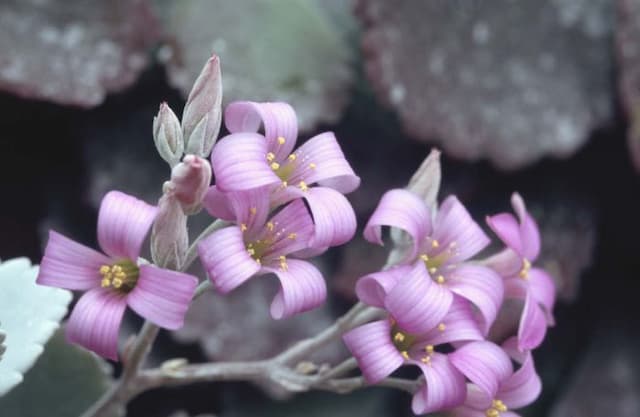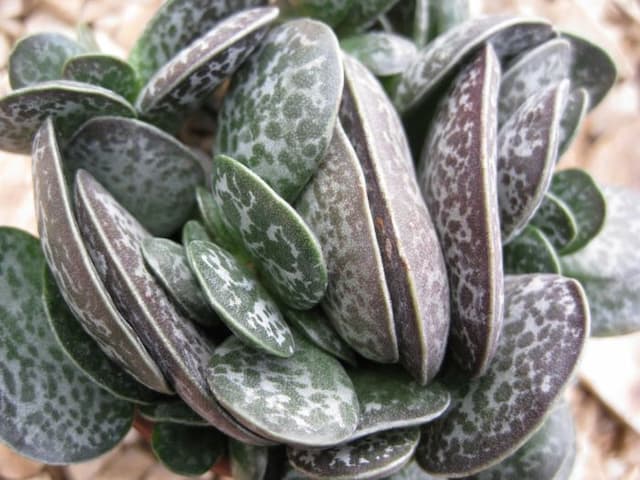Paddle plant Kalanchoe thyrsiflora



ABOUT
Kalanchoe thyrsiflora, commonly known as Paddle plant, is an evergreen succulent shrub that typically grows 1-3 feet tall and wide.
It has long, narrow, pointed, dark green, fleshy leaves that are arranged in opposite pairs along the stem. The leaves are usually about 2-4 inches in length and have a scalloped edge.
The flowers of Kalanchoe thyrsiflora are borne on short, erect stems and are bell-shaped, with four white petals arranged in a cross pattern. The flowers are 1-2 inches in diameter and bloom in the late winter to early spring.
About this plant
 Names
NamesFamily
Crassulaceae
Synonyms
Paddle plant, Flapjacks, Desert cabbage, Contracted-panicle-flowered, Kalanchoe, White lady, Geelplakkie, Meelplakkie, Plakkie
Common names
Kalanchoe tetraphylla
 Toxicity
ToxicityTo humans
Kalanchoe thyrsiflora is generally considered non-toxic to humans, however, there have been reports of contact dermatitis from handling the plant. It should still be handled with caution.
To pets
Kalanchoe thyrsiflora is toxic to animals if eaten, and can cause vomiting, diarrhea, and other gastrointestinal issues. It is best to keep this plant away from pets and small children to prevent accidental ingestion.
 Characteristics
CharacteristicsLife cycle
Perennials
Foliage type
Evergreen
Color of leaves
Dark green
Flower color
Green, yellow
Height
Up to 3 feet
Spread
Up to 3 feet
Plant type
Succulents
Hardiness zones
11
Native area
Madagascar
Benefits
 General Benefits
General BenefitsKalanchoe thyrsiflora is known for its air purifying properties. It is said to remove pollutants such as formaldehyde, benzene, and trichloroethylene from indoor air;
The plant is believed to reduce stress and anxiety, making it a great choice for busy households;
Also, Kalanchoe thyrsiflora is said to improve sleep quality, which can be especially helpful for those who struggle with insomnia;
It is rich in antioxidants, which can help protect against free radical damage and improve overall health. Medical Properties
Medical PropertiesKalanchoe thyrsiflora has been found to have antimicrobial properties, including against bacteria, fungi, and protozoa;
This plant has been shown to reduce inflammation and pain;
Kalanchoe thyrsiflora has been used to treat wounds and promote healing;
Paddle plant has been used as a diuretic to reduce swelling;
It has been used as a cardiotonic to improve heart health;
Kalanchoe has been found to have antioxidant properties, which can help protect against cell damage;
The plant has been found to be effective at treating fungal infections.
It is important to note that Kalanchoe thyrsiflora is not a stand-alone treatment and it is important to consult a specialist before using. Air-purifying Qualities
Air-purifying QualitiesKalanchoe thyrsiflora has been found to have some air purifying properties.
These properties include reducing indoor air pollution levels, specifically formaldehyde, benzene, and trichloroethylene. However, the plant was not included in the NASA Clean Air Study. Other Uses
Other UsesThe leaves of Kalanchoe thyrsiflora contain compounds that are toxic to certain types of insects, and can be used to repel them when crushed and applied to the skin;
In some cultures, the leaves of Kalanchoe thyrsiflora are used to treat a variety of ailments, such as wounds, burns, and skin infections;
Kalanchoe thyrsiflora has been shown to remove certain pollutants from the air, making it a popular choice for indoor plants;
The succulent leaves and brightly-colored flowers of Kalanchoe thyrsiflora make it a popular choice for gardens and indoor decoration;
The leaves of Kalanchoe thyrsiflora are used to make a paste which is applied to the skin for treating acne, eczema, and other skin issues.
Interesting Facts
 Feng Shui
Feng ShuiFeng Shui practitioners suggest using the Paddle plant in the east corner of your home to bring in positive energy, which is associated with wealth, health, and success.
 Zodiac Sign Compitability
Zodiac Sign CompitabilityARIES, CAPRICORN, and SCORPIO
Aries is the leader of the zodiac, and is associated with strength and ambition.
Capricorn is the hardworking and practical one, and is associated with stability and success.
Scorpio is the intuitive and passionate one, and is associated with mystery and transformation.
All three signs are compatible with Kalanchoe thyrsiflora and its symbolism of wealth, health, and success. Plant Symbolism
Plant SymbolismIn some cultures, Kalanchoe thyrsiflora is seen as a symbol of endurance, resilience and protection. It is believed to bring good luck and ward off bad luck, as well as be a sign of long-lasting friendship and loyalty.
In some areas, it is also seen as a symbol of love, as it is often used to decorate weddings and other special occasions.
 Water
WaterIt is recommended that you water your Kalanchoe thyrsiflora once a week, allowing the soil to dry out slightly between waterings.
Water the plant thoroughly until water runs out of the drainage holes in the bottom of the pot.
Avoid overwatering, as this can lead to root rot. Light
LightThe best lighting conditions for Kalanchoe thyrsiflora is bright, indirect light.
It should be placed in a spot where it will get plenty of light but not be in direct sunlight. Too much direct sunlight can scorch the leaves, so it's best to keep it out of any direct sunlight. Temperature
TemperatureThe best temperature for Kalanchoe thyrsiflora is between 65-75°F.
Kalanchoe thyrsiflora can tolerate temperatures as low as 55°F and as high as 85°F. Pruning
PruningPruning Kalanchoe thyrsiflora is relatively easy. To encourage healthy growth and flowering, you should prune the plant regularly. You can start pruning when the plant is young and continue throughout its life. Prune off any dead or dying leaves or stems. This will prevent the spread of any diseases or pests that may be affecting the plant. Prune any stems that are leggy or bare at the base. This will encourage new growth and keep the plant looking full and healthy. Prune back the stems that are growing too tall. This will help keep the plant compact and bushy. Remove any flowers or buds that have already bloomed. This will help promote further blooms and a healthy flowering cycle. Prune away any stems that have too many flowers. This will help keep the plant from becoming overburdened and will ensure that the individual flowers receive enough sunlight and nutrients.
 Cleaning
CleaningAs needed
 Soil
SoilKalanchoe thyrsiflora prefers a soil that is well-draining, slightly acidic, and nutrient-rich.
A good soil mix for this plant would be a combination of 1 part peat moss, 1 part perlite, and 1 part compost.
Be sure to adjust the pH to between 5.5 and 6.5 to ensure optimal growth.
Additionally, it is important to fertilize the plant with a balanced fertilizer every few weeks to provide the necessary nutrients for growth. Repotting
RepottingKalanchoe thyrsiflora should be repotted every 2-3 years, or when the plant has outgrown its current pot.
 Humidity & Misting
Humidity & MistingThe optimal humidity level for Kalanchoe thyrsiflora is around 40-50%.
Higher humidity can lead to fungal infections and lower humidity can cause excessive leaf-drop. Suitable locations
Suitable locationsIndoor
All year round
Outdoor
Kalanchoe thyrsiflora can be grown outdoors in a variety of climates. This succulent is native to South Africa, so it can handle temperatures down to 50°F.
It prefers bright light and warm temperatures, so growing it in a sunny spot is best. It can also tolerate some shade and wind.
For best results, plant it in well-draining soil that is slightly acidic (pH 6.1-6.5). Water only when the soil is dry to the touch and fertilize lightly during the growing season. Prune dead or damaged leaves as needed.Hardiness zone
12 - 13 USDA
 Life cycle
Life cycleKalanchoe thyrsiflora will typically germinate from either seeds or cuttings. Seeds should be sown in a moist, well-draining soil mix and kept at a temperature of between 68-86°F. Cuttings should be taken from the plant’s stem and placed in a similar soil mix.
Once the seeds or cuttings have germinated, the seedling stage begins. During this stage the plant will begin to develop its root system and start to grow.
As the plant matures, it will begin to form flowers and develop a more compact form. It will also start to become more drought tolerant and can be pruned to encourage a denser growth habit.
During the flowering stage, the plant will produce a variety of flowers ranging in color from white to yellow to pink. The flowers will be followed by small, greenish-gray fruits.
Once the plant has reached maturity, it will begin to form fewer flowers. At this point, the plant is considered to be in its mature stage. Propogation
PropogationPropogation time
Spring - early summer
By STEM CUTTINGS:
Stem cuttings can be taken from the plant, with at least two nodes present on them, and rooted in moist soil. This process can take anywhere from a few weeks to several months, depending on the climate.
By LEAF CUTTINGS:
Leaves can be cut from the plant and rooted in a potting medium. This process usually takes about 3-4 weeks for the leaves to form roots.
By DIVISION:
Kalanchoe thyrsiflora can be divided when repotting. The divided sections can then be potted up in separate containers to create new plants.
By LAYERING:
The stems of Kalanchoe thyrsiflora can be bent and pinned down into the soil, where they will then form roots. This method usually takes about 1-2 months to form roots.
By SEEDS:
Seeds can be sown in a potting medium, with the seeds covered lightly with soil. The seeds should be kept moist, and can take anywhere from 1-3 months to germinate.
 Pests
PestsSpider mite, Whitefly, Thrips, Scale insects, Mealybug, Aphid
 Diseases
DiseasesRoot Rot, Powdery mildew, Leaf spot









